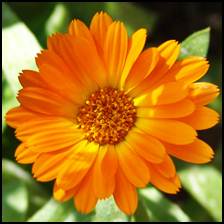You entered English Marigold, the more common name is...

Marigold
SCIENTIFIC NAME:(Calendula officinalis)
The Calendula is probably native to southern Europe though its long history of cultivation makes its precise origin unknown, and may possibly be of garden origin. It is also widely naturalized further north in Europe (north to southern England) and elsewhere in warm temperate regions of the world.
An annual or short-lived herbaceous perennial the Pot Marigold grows from 1 to 3 feet tall. Its flowers are orange or yellow, with a single row of petals, usually, sometimes double. The leaves are spirally arranged, 1.5 to 6 inches long, simple, and slightly hairy. The flower heads range from pastel yellow to deep orange, and are 1 to 2.5 inches across, with both ray florets and disc florets.
Common Names:
Pot Marigold, Common Marigold, Ruddles, Garden Marigold, English Marigold, Scottish Marigold, Field Marigold

Uses:
Marigold florets are considered edible. They are often used to add color to salads, or added to dishes as a garnish and in lieu of saffron. The leaves are edible but are often not palatable.A Marigold infusion or tincture is used to treat hyper-acid gastritis, duodenal ulcer, infected uterus, cancerous ulcerations, inflammations and liver ailments.
Marigold tincture is effective at stabilizing the menstrual cycle and marigold tea, if drunk a week before the appearance of the menstrual cycle, it can alleviate the pains, especially in cases of anemic persons.
Leucorrhea, acne, burns, chilblains, infected wounds, skin cancer, breast cancer, mycosis and ulcerous breast wounds are all treated with marigold lotions or with bath water containing marigold.
Marigold oil is used in treating dry sensitive skin; it is also recommended that the marigold oil be used to speed up the healing process. The oil has energizing and soothing effects and can also strengthen the vascular fragility of blood circulation. The oil is recommended in skin inflammations and also in treating bruises and eczemas.
Juice of the Marigold can be poured on a clean cotton cloth and applied to afflicted area as a treatment against skin cancer and to reduce the appearance of birth marks or dark spots.
In cases of dizziness or headache a marigold decoction is recommended. It can be used in cases of bladder disorders, rachitis, cough, stomach aches.
Applications:
Infusion:
Pour 1 (8 oz.) cup of boiling water over 2 Tbls of dry flowers, cover and let steep for 15 to 20 minutes, then strain. The tea is drunk warm three times a day, half an hour before primary meals. A more concentrated infusion is made from 4 Tbls of dry marigold flowers added to ¾ (6 oz.) cup of boiling water from which four spoons are taken each day. To destroy the protozoan Trichomonas vaginalis infuse 10g of flowers added to 100g water and allow to get to a comfortable temperature, strain and use as a douche.
Tincture:
The marigold tincture is obtained by macerating 20g of flowers, freshly picked and put in 3 ounces of alcohol heated to 70 degrees and allowed to rest in a warm place for 8 days. To adjust the menstrual cycle it is necessary to dissolve 30 drops of tincture in a small quantity of water and then consume 3 spoons of the mixture a day.
A spoonful of tincture, obtained from macerating four spoons of marigold flowers in 3 ounces of alcohol heated to 90 degrees and allowed to rest in a warm place for a period of 10 days, is mixed in 3 ounces distilled water. From this a mixture is obtained that can be used to treat pale or greasy complexions.
Decoction:
Marigold decoction which is used for treating dizziness and headaches, is made from 10g of marigold flowers placed in 6 ounces of boiling water. It is consumed by taking 1 to 3 teaspoons three times a day. It is also an excellent diuretic treatment.
Warnings:
Calendula has been known to cause allergic reactions. Pregnant and lactating women, as well as young children should not use this herb.
With any herb, there is the risk of an allergic reaction. Small children and pregnant women should use additional caution when considering the use of herbal remedies.





